Books aren’t merely objects we store for later; their presence quietly shapes mood, memory, and imagination—so crafting a dedicated home library can transform how you live with stories every single day. Drawing on current design thinking, from Japandi calm to playful secret doors, these ideas balance function and personality, letting even small corners feel like grand literary retreats. Whether you own a sprawling collection or just a budding shelf, you’ll find ways below to showcase volumes beautifully, encourage daily reading rituals, and future-proof your space for digital-plus-print lifestyles. Ready to discover an approach that fits your square footage and your spirit? Let’s open the first chapter.
1. Floor-to-Ceiling Library Wall
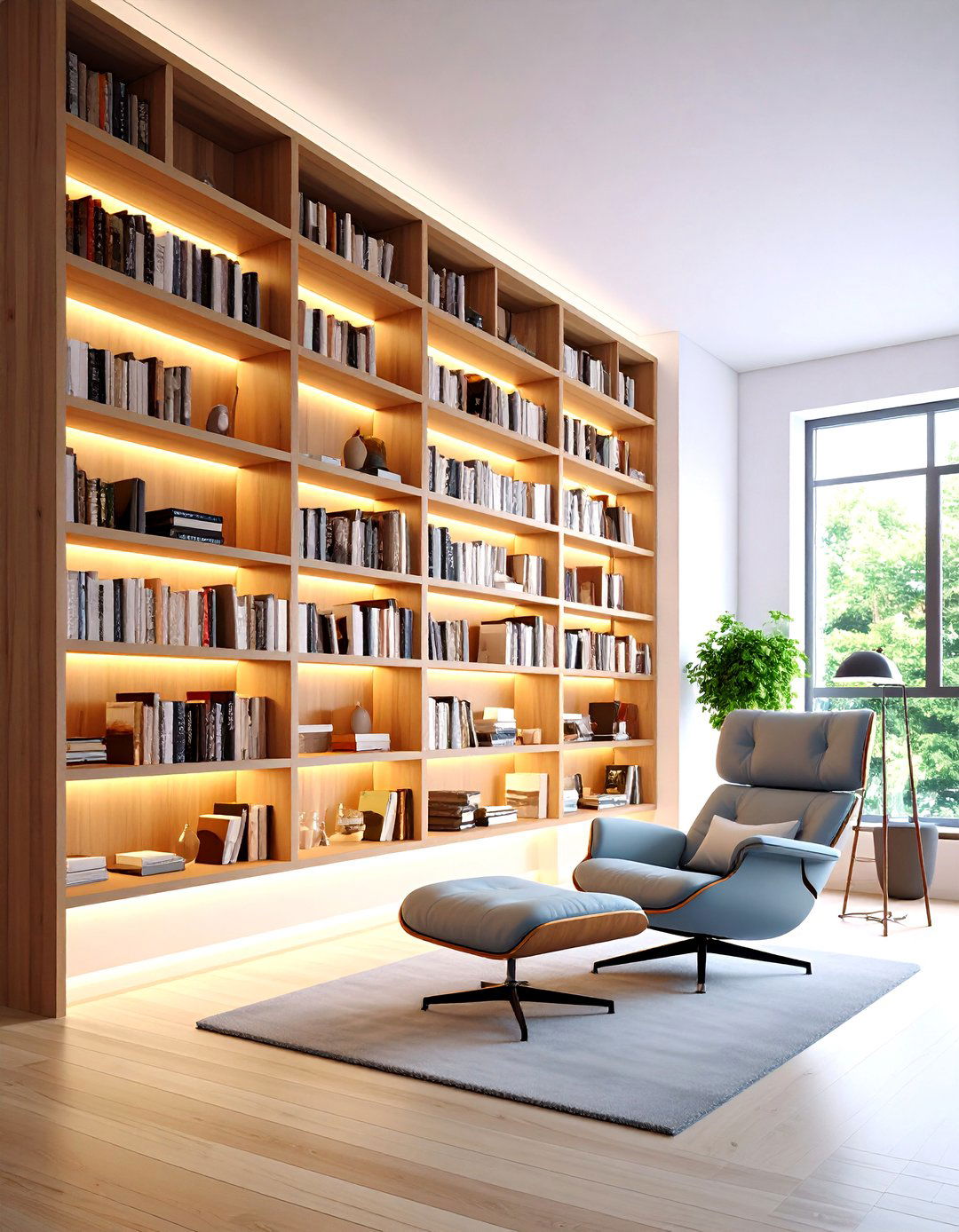
A soaring, floor-to-ceiling home library wall instantly turns an ordinary room into a private book emporium, delivering maximum storage without stealing precious floor space. Mount full-height shelving along one solid wall—preferably the one opposite your main light source—so spines glow naturally throughout the day. Include adjustable shelves to accommodate oversized art tomes and compact paperbacks alike, and run a narrow picture-rail ladder on a ceiling track for safe, stylish access to upper tiers. Integrated LED strips tucked under each shelf keep colors crisp after dusk while doubling as ambient mood lighting. Finish with a sculptural lounge chair angled half-turned toward the shelves to invite spontaneous browsing. Homes & Gardens
2. Window-Seat Home Library Alcove
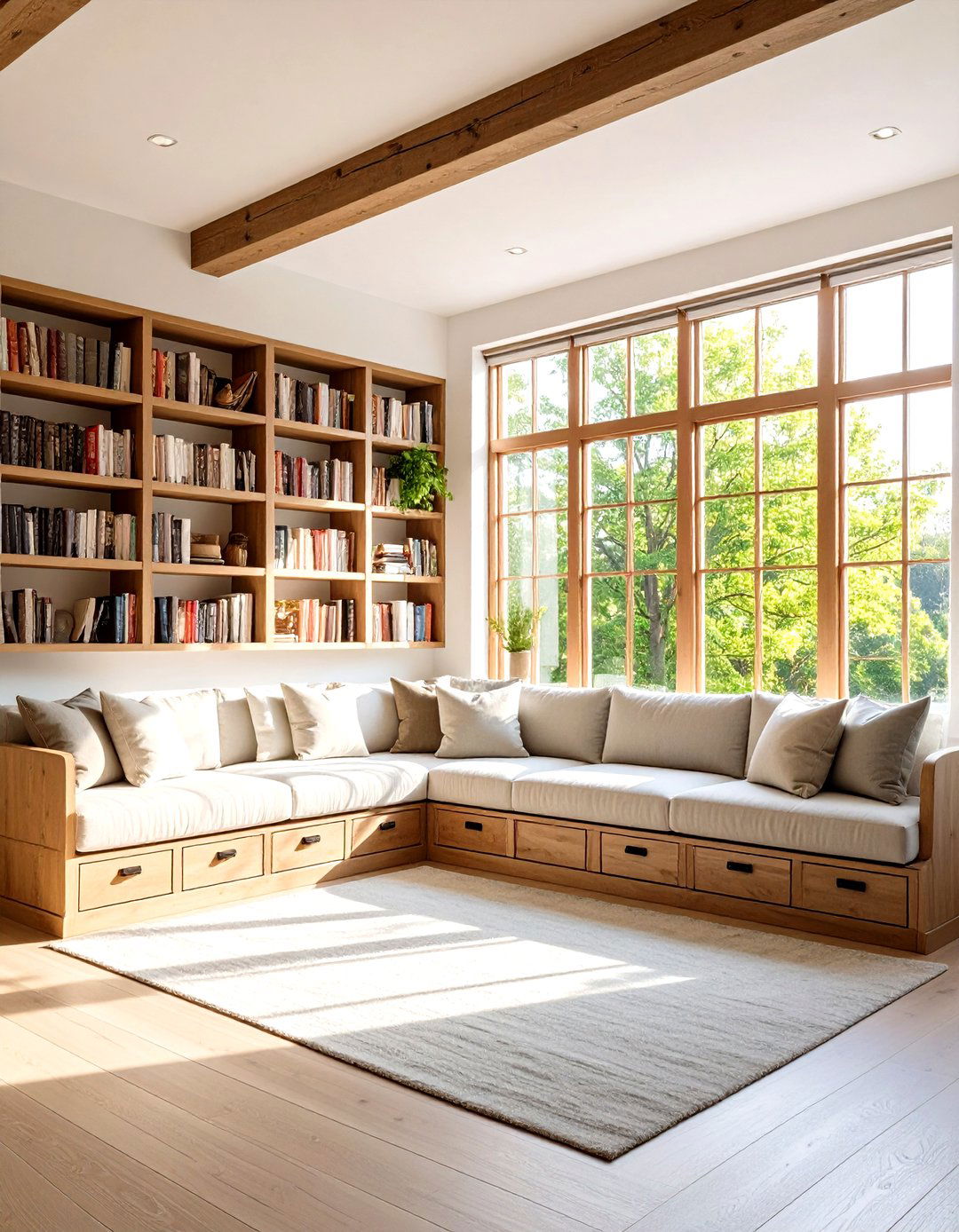
The union of sunlight and stories feels timeless, so framing a wide window with custom bookcases creates a reading pier that’s equally charming and space-savvy. Build bookshelves tight to the casing on both sides, add a deep, cushioned bench beneath, and cap the seat with hidden drawers for throw blankets. A mix of closed bases and open uppers keeps visual weight balanced while protecting fragile editions from direct glare. For tiny rooms, paint the shelving the same hue as the walls so the whole alcove reads like original architecture, then layer sheers that filter harsh light without blocking that dreamy view. One Kindesign
3. Under-Stair Reading Nook Library
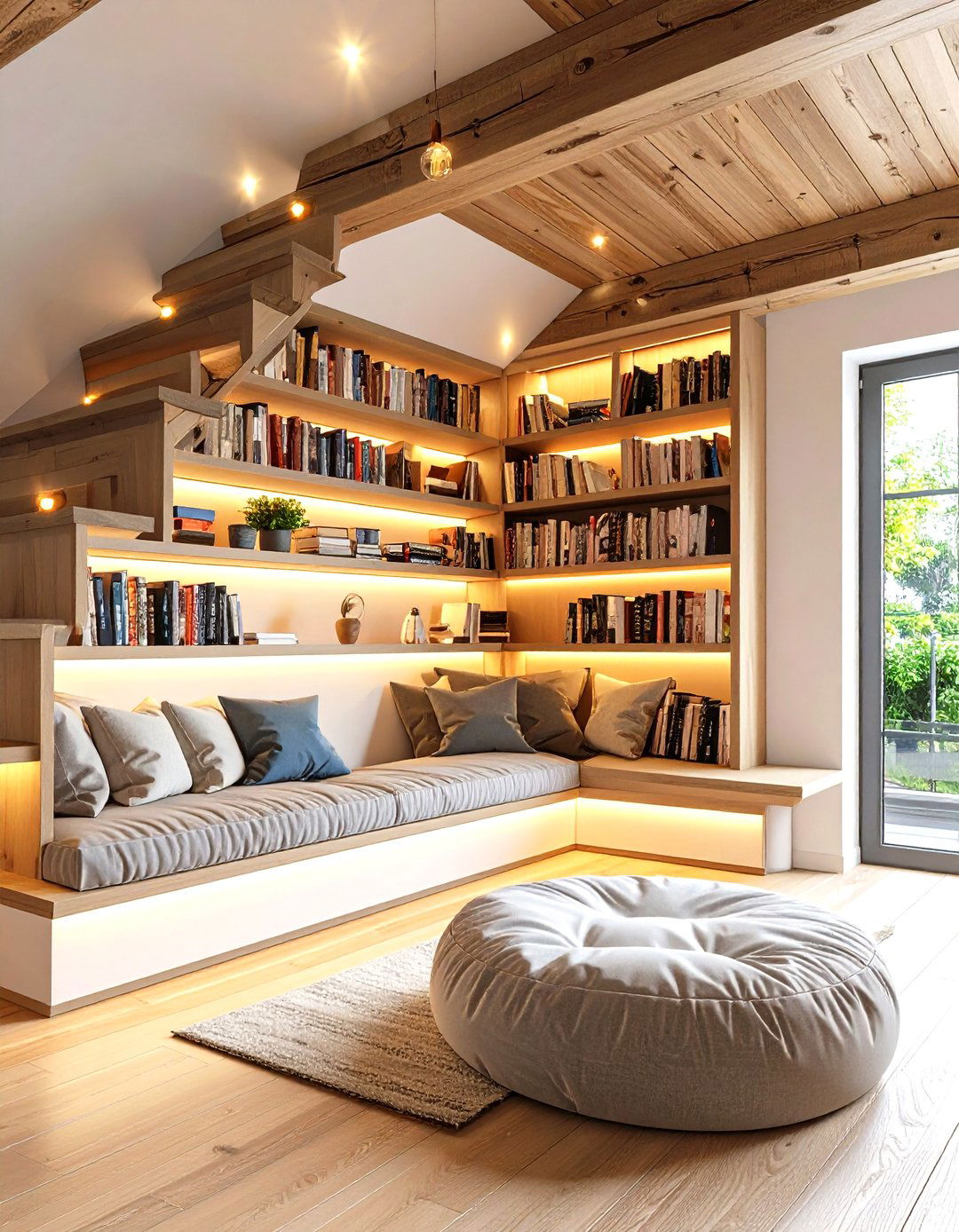
Unlike unused voids that gather dust, that triangular cavity beneath the staircase can evolve into a snug, under-stair home library. Start by lining back and side walls with shallow built-ins cut precisely to tread angles; even eight-inch depth holds paperbacks beautifully. A low bench or beanbag nestled inside grounds the nook, while battery-powered puck lights on motion sensors make entry feel magical. Stain shelves the same tone as stair risers for cohesion, or contrast boldly to spotlight the hidden gem. Kids love the secret-cave vibe, but adults also appreciate slipping here for five quiet pages between chores. Pinterest
4. Multifunctional Cloffice Library
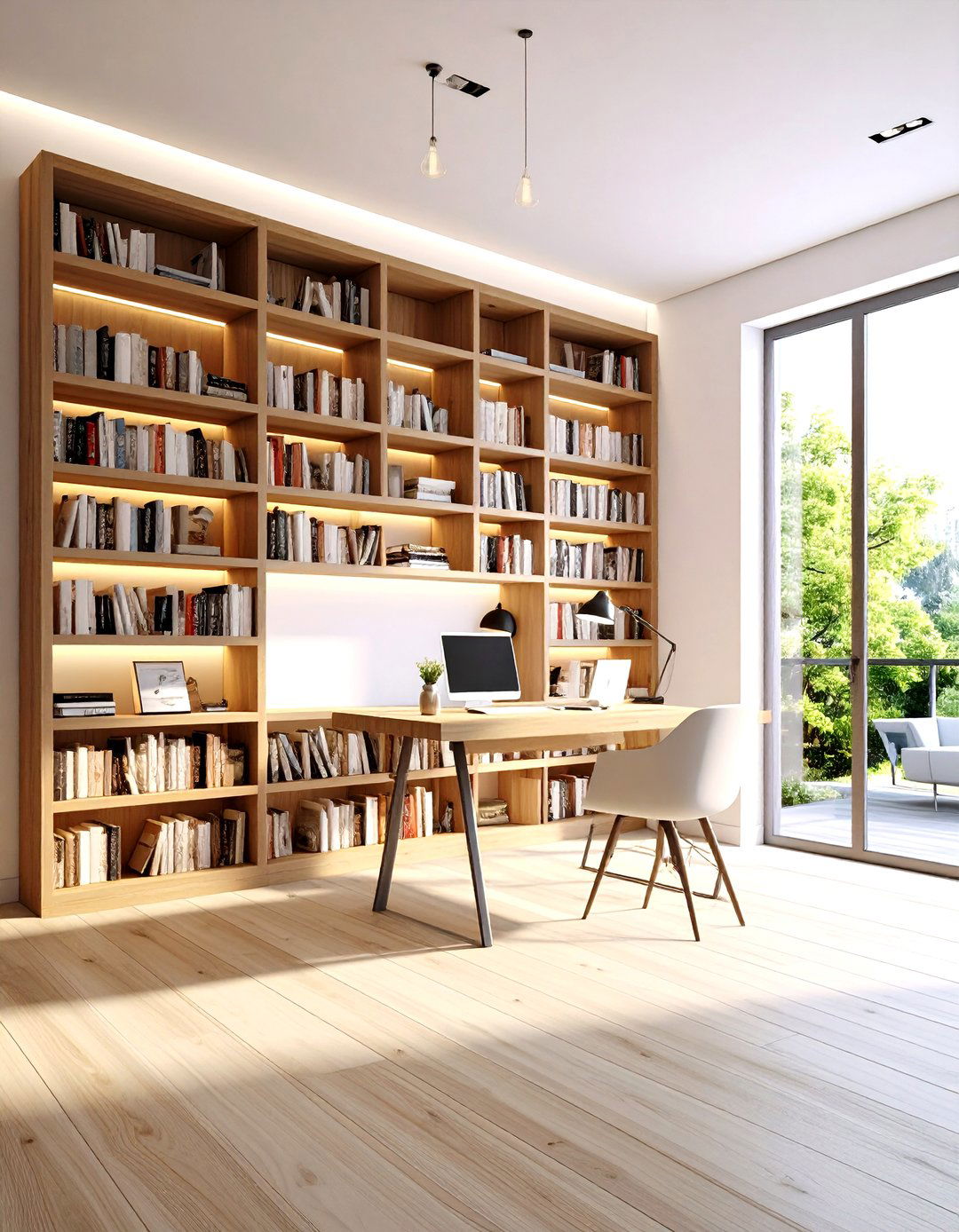
As remote work remains common, consider merging closet and office into a “cloffice” that doubles as a miniature home library. Remove bi-fold doors, install wall-to-wall shelving overhead, slide in a compact desk that floats above file drawers, and run LED strip lighting around the opening’s perimeter to prevent shadows. Keep frequently consulted references at elbow height and store archival novels above sightline. At day’s end, you can close modern pocket doors or a reclaimed barn slider to hide the workspace, leaving only an attractive book backdrop on view from the hallway. Elle Decor
5. Secret Bookcase Door Library
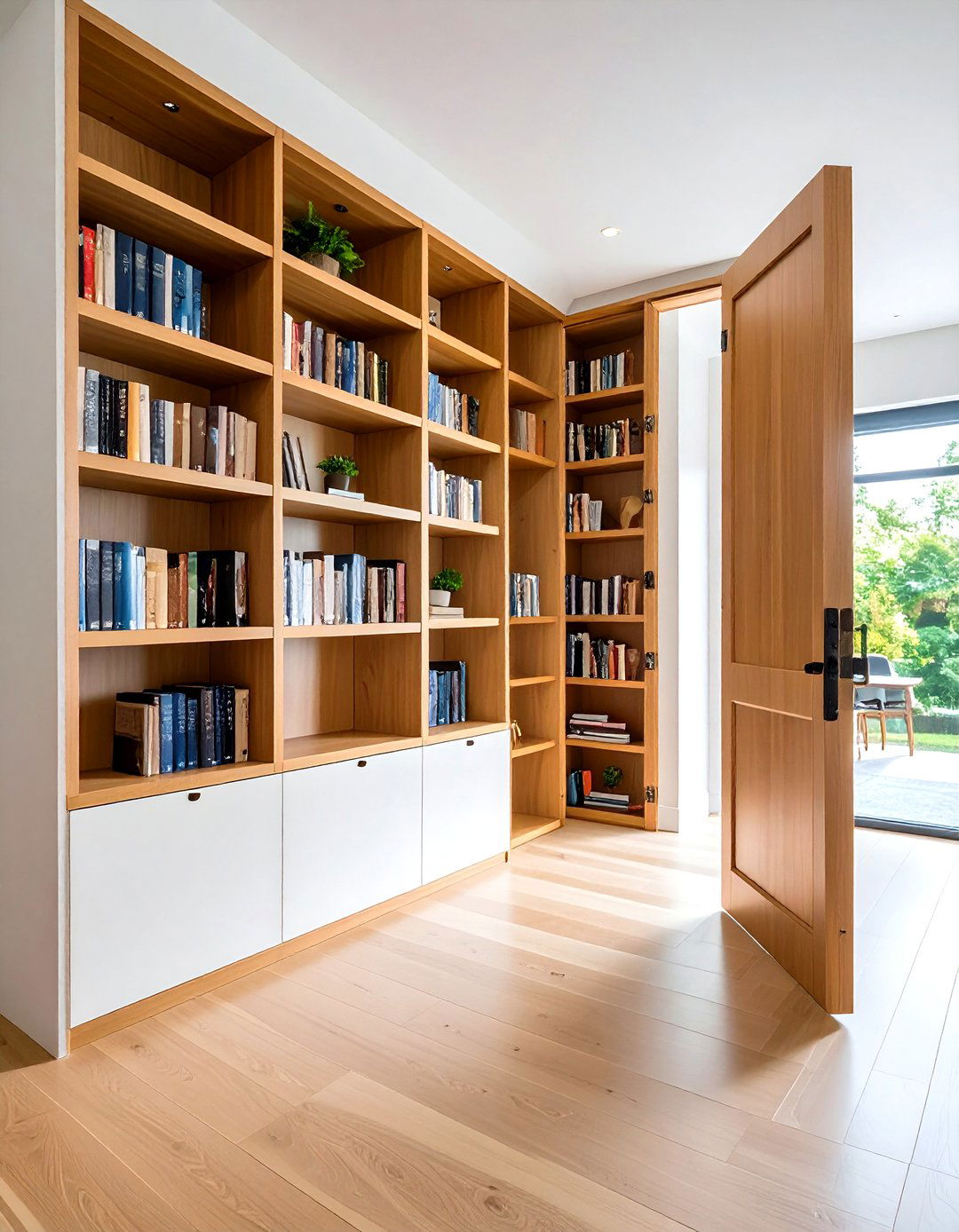
For readers who crave a dash of theater, a pivoting bookcase that disguises a passage into your home library offers pure storybook fantasy. Prefabricated concealed hinges (often marketed as Murphy doors) support the weight safely while keeping alignment flush with adjoining shelves. Balance the load by arranging heavier hardbacks near the hinge edge and lightweight décor toward the handle side, ensuring smooth swing. Beyond delight, the hidden wall grants privacy for meditation, remote meetings, or safeguarding valuables—proof that whimsy and practicality can share the same spine. The Times Better Homes & Gardens
6. Color-Coded Shelf Styling Library
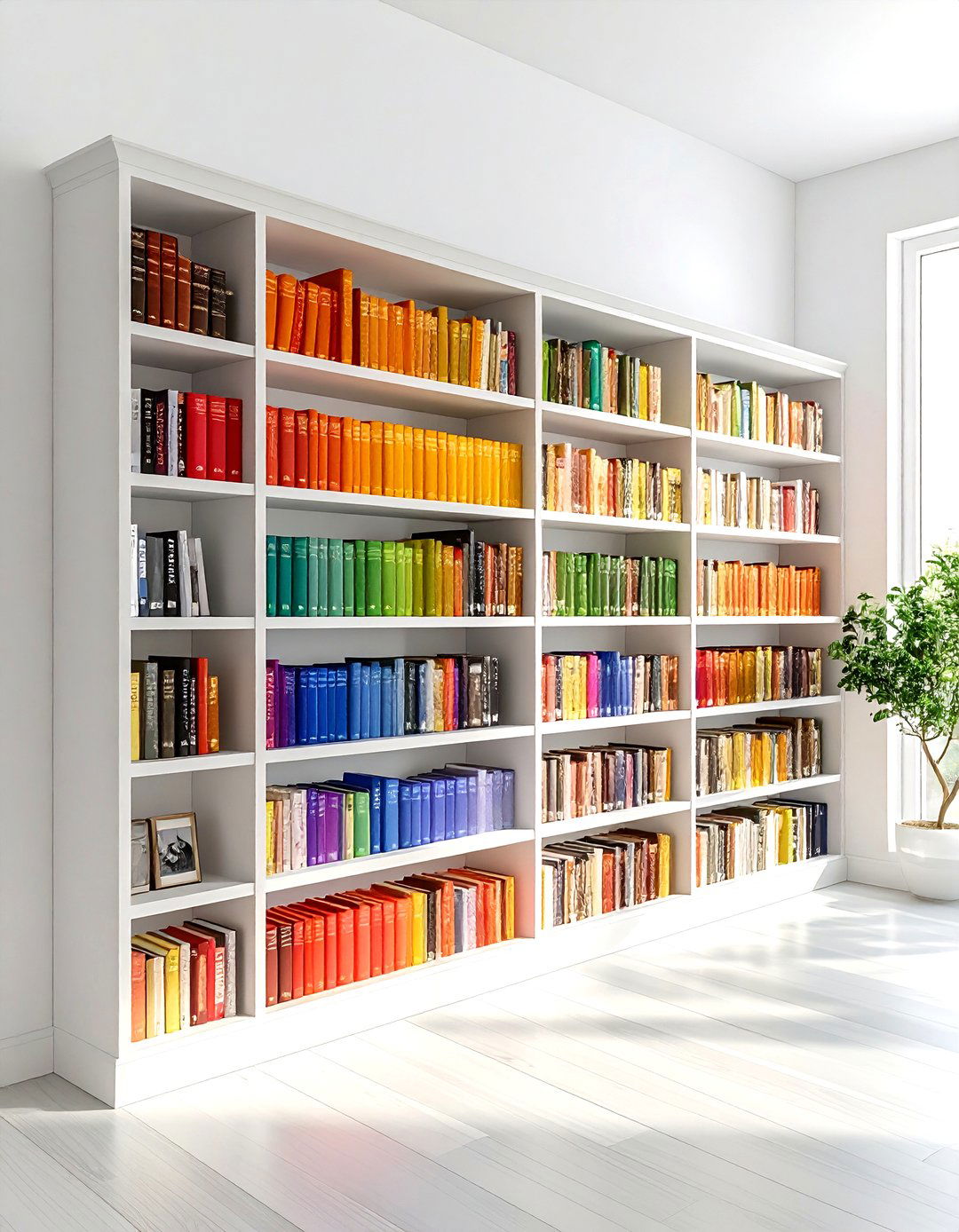
Certainly, arranging a home library by hue sparks joy and clarifies cluttered walls into an intentional art piece. Sort dust jackets into a rainbow gradient—or for a subtler palette, group by warm, cool, and neutral blocks—and keep sets intact by wrapping them in matching kraft covers with colored spine labels. To avoid looking staged, pepper monochrome clusters with metallic bookends, tiny sculptures, or framed family photos that echo the dominant shade. The system is surprisingly functional: once you memorize that your travel guides sit in “sunset orange,” retrieval happens in seconds. Homes & Gardens
7. Biophilic Home Library with Indoor Plants
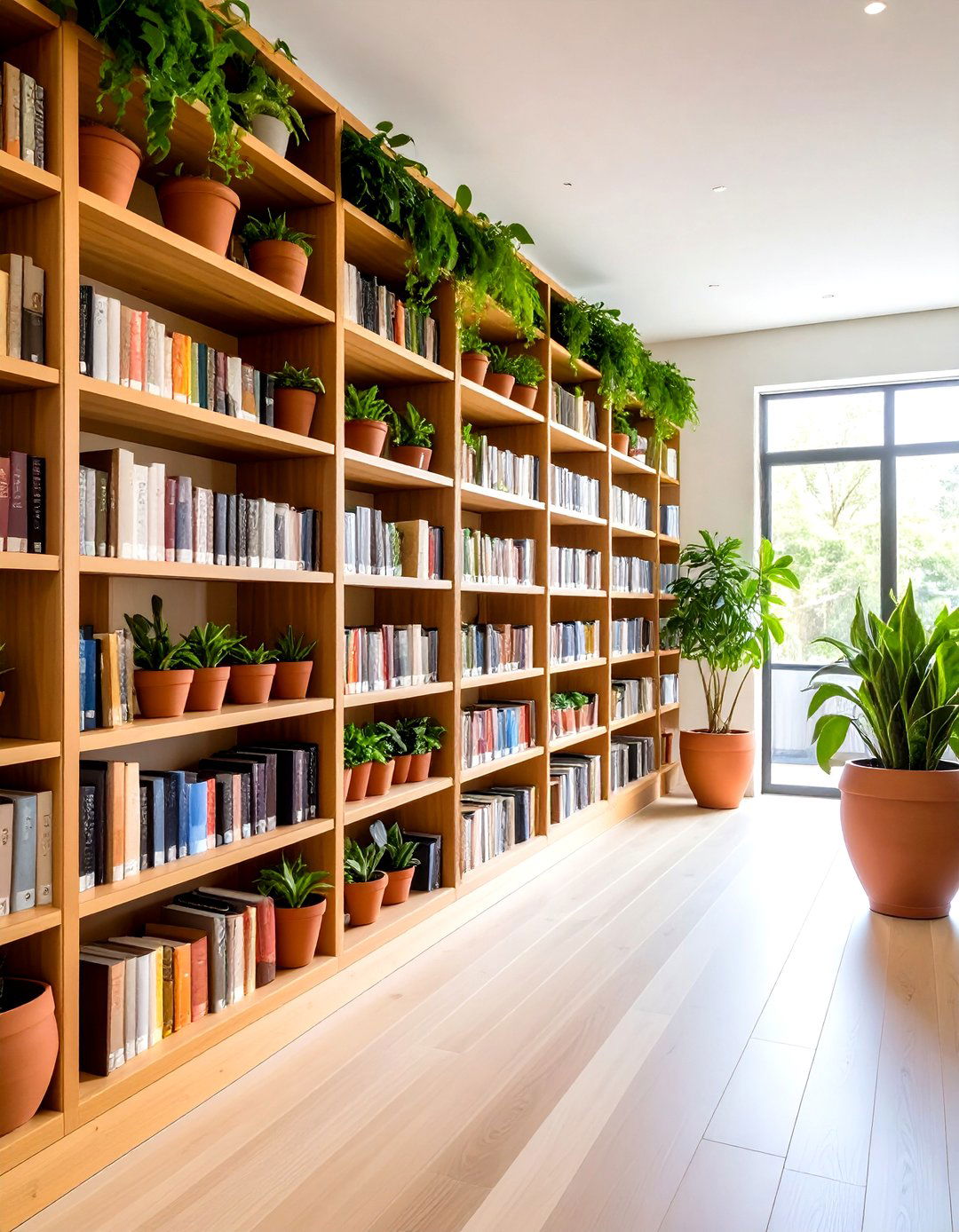
Bringing leafy companions into a home library calms the nervous system and buffers acoustics for deeper concentration. Position trailing pothos or philodendron atop upper shelves so vines cascade against spines, and reserve sturdy lower cubbies for terracotta pots of snake plants that tolerate lower light. A small tabletop humidifier protects both foliage and delicate paper from excessive dryness, while moss art panels double as acoustic dampers behind a reading chair. This living ecosystem subtly signals slower rhythms, reminding you to breathe between chapters. Elle Decor
8. Modular Shelving Library for Renters
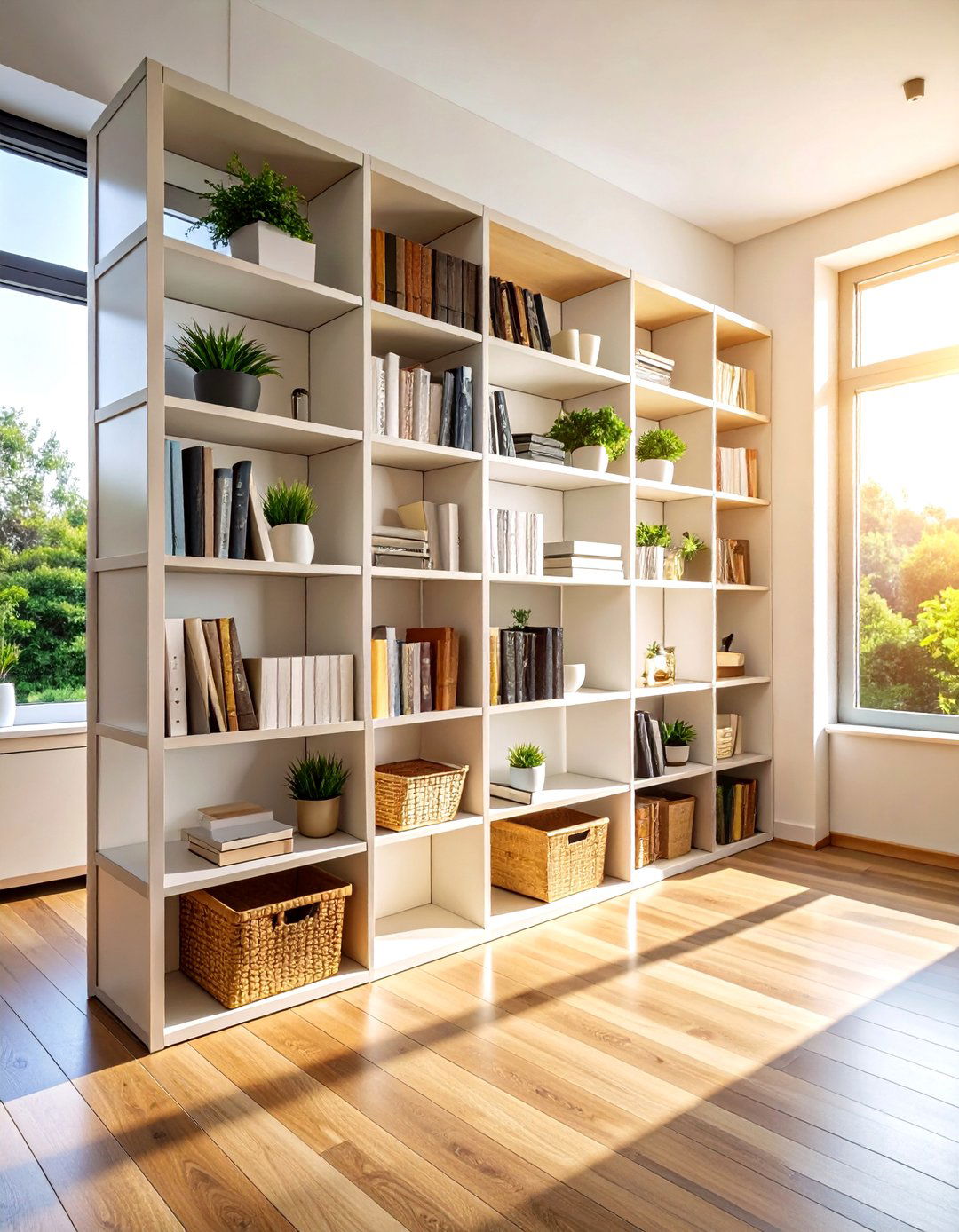
When you don’t own the walls, a freestanding modular home library solves storage without a single drill hole. Choose stackable cube units or tension-rod bookcases that brace between ceiling and floor; both extend vertically to maximize volume while disassembling easily on moving day. Combine closed baskets in lower cubes for miscellaneous gadgets and open display cubes above for beloved series. Because each module weighs little on its own, you can experiment with creative zigzag layouts that adapt to tomorrow’s apartment footprint. Homes & Gardens
9. Loft Mezzanine Home Library
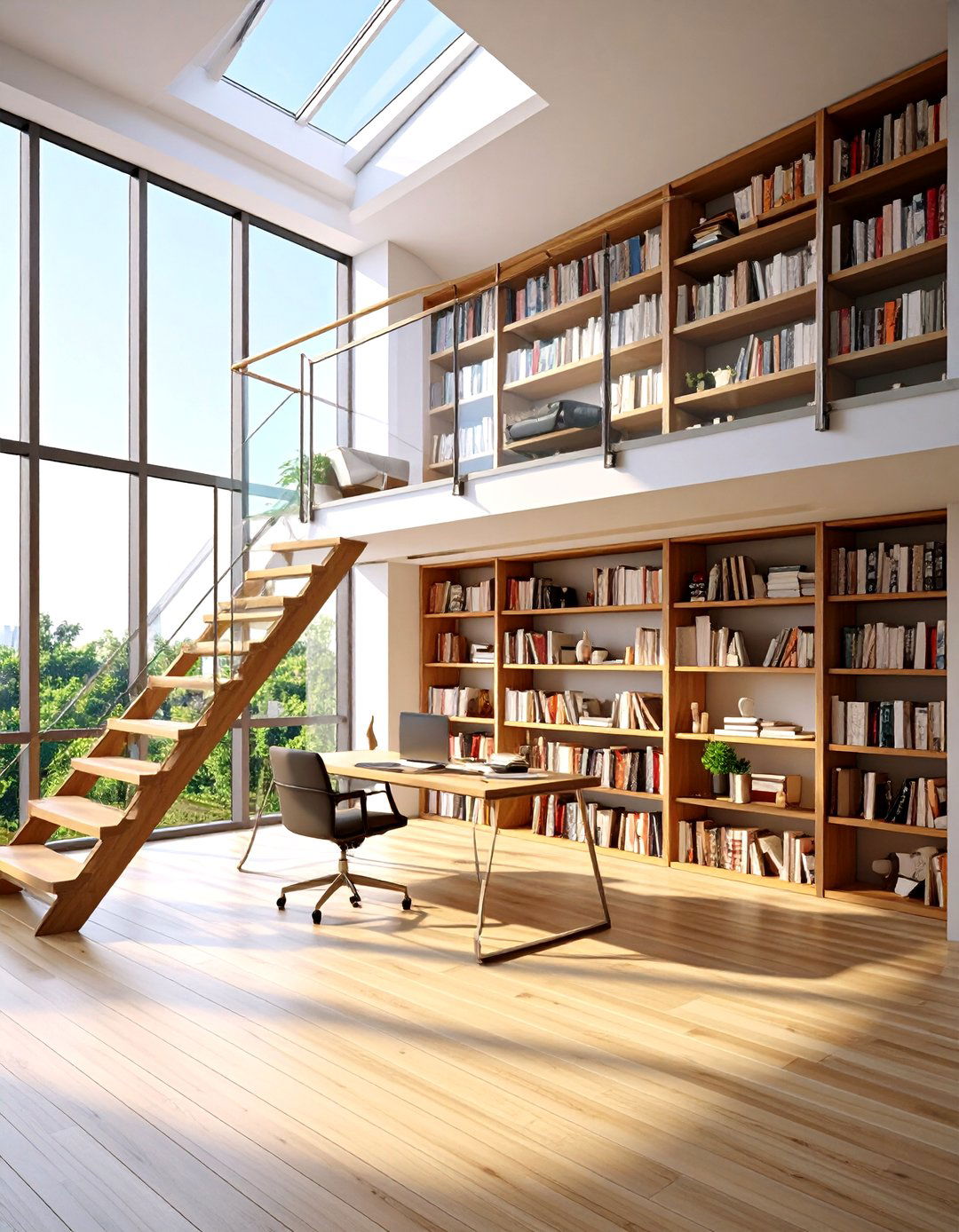
For homes with double-height ceilings, installing a loft mezzanine lined with books celebrates vertical space and grants a bird’s-eye perch for quiet work. Steel frame kits simplify construction and allow slim timber decking to keep sightlines open below. Integrate glass balustrades so spines remain visible from the living area, and float a minimalist desk against one railing for laptop sessions amid stacks. Retractable ships-ladder stairs fold against the wall when unused, preserving floor area beneath and meeting many building codes for secondary access. Homes & Gardens
10. Japandi-Inspired Minimalist Library
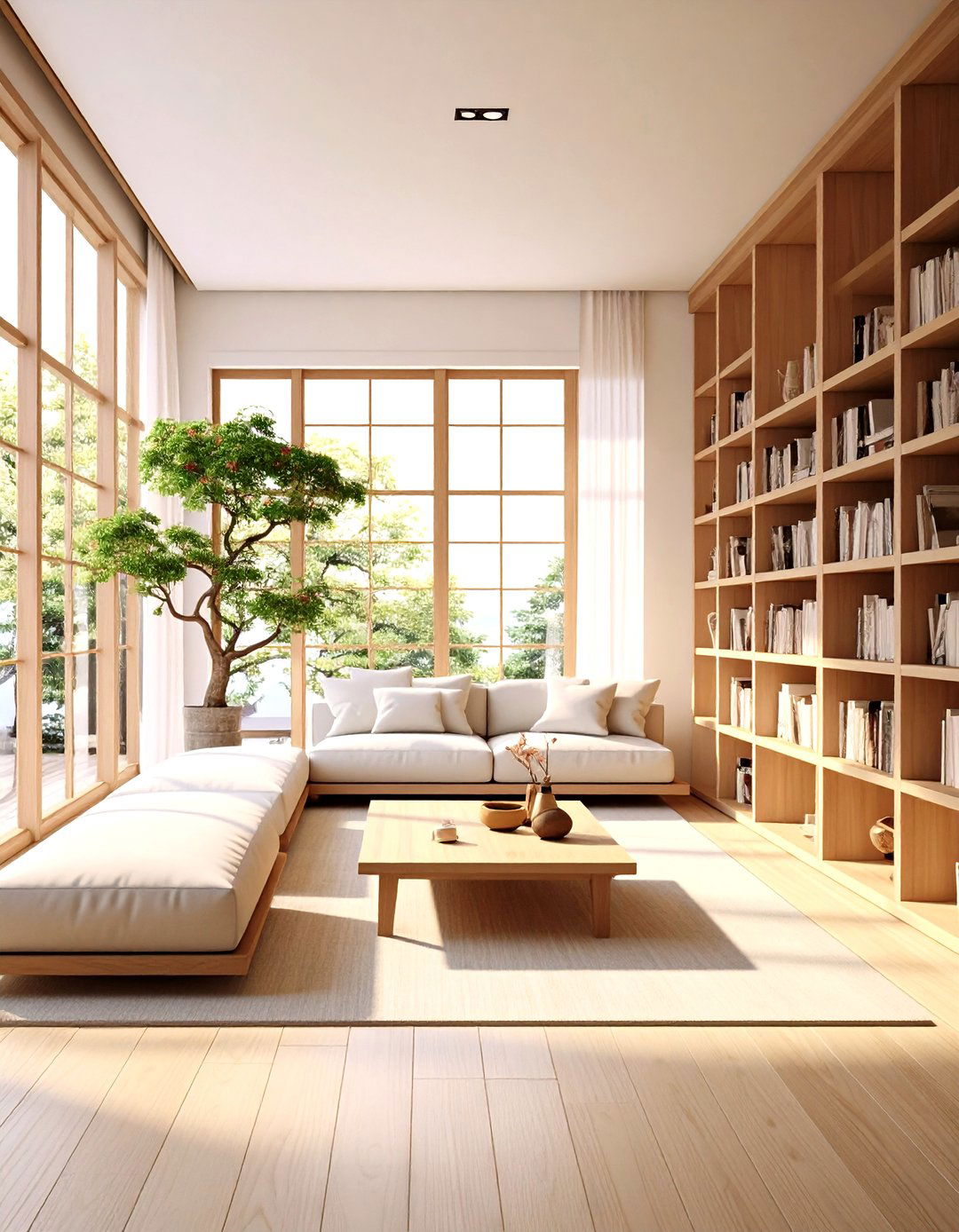
Combining Scandinavian efficiency with Japanese serenity, a Japandi home library pares the environment to essentials so every volume breathes. Opt for low, light-oak shelving built in rhythmic bays, leaving alternating compartments empty to introduce negative space. Tatami-style floor cushions around a simple timber chabudai table encourage screen-free reading gestures, while soft linen curtains diffuse daylight into paper-friendly warmth. Accent the tableau with a single bonsai on a floating shelf—a living metaphor for lifelong cultivation of knowledge. YouTube
11. Library with Integrated LED Lighting
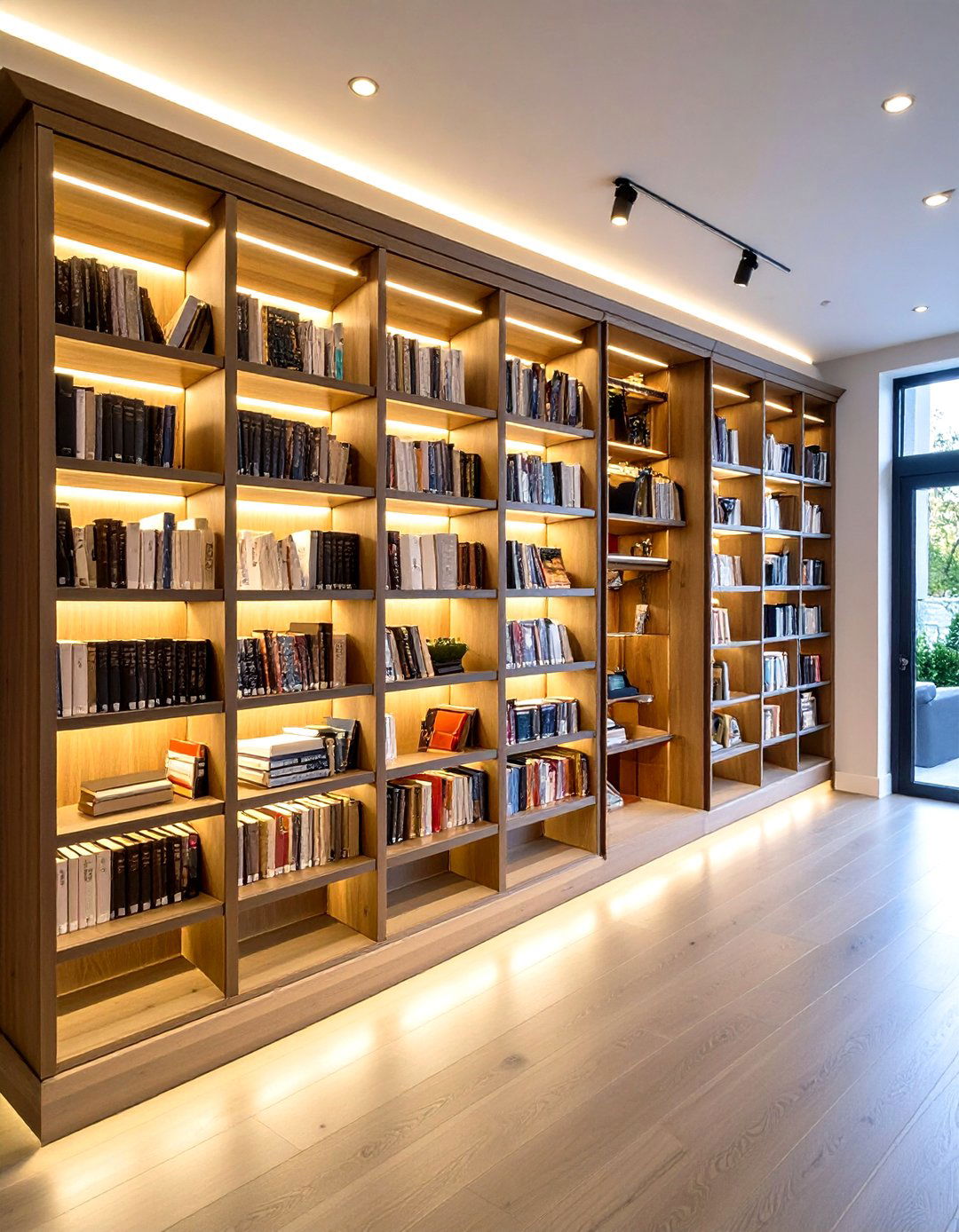
With, integrated lighting elevates a home library from functional to gallery quality. Fit 3000-Kelvin LED tape along rear shelf lips so illumination grazes the spines, preventing hotspots and adding gentle ambiance after sunset. A smart dimmer paired with motion detection ensures bulbs activate only when someone approaches, protecting book bindings from unnecessary heat. For cabinets with glass doors, mini puck lights in each bay highlight special editions like jewels in a case, while top-of-shelf uplighting bounces glow onto the ceiling for overall balance. Homes & Gardens
12. Convertible Living-Dining Library Wall
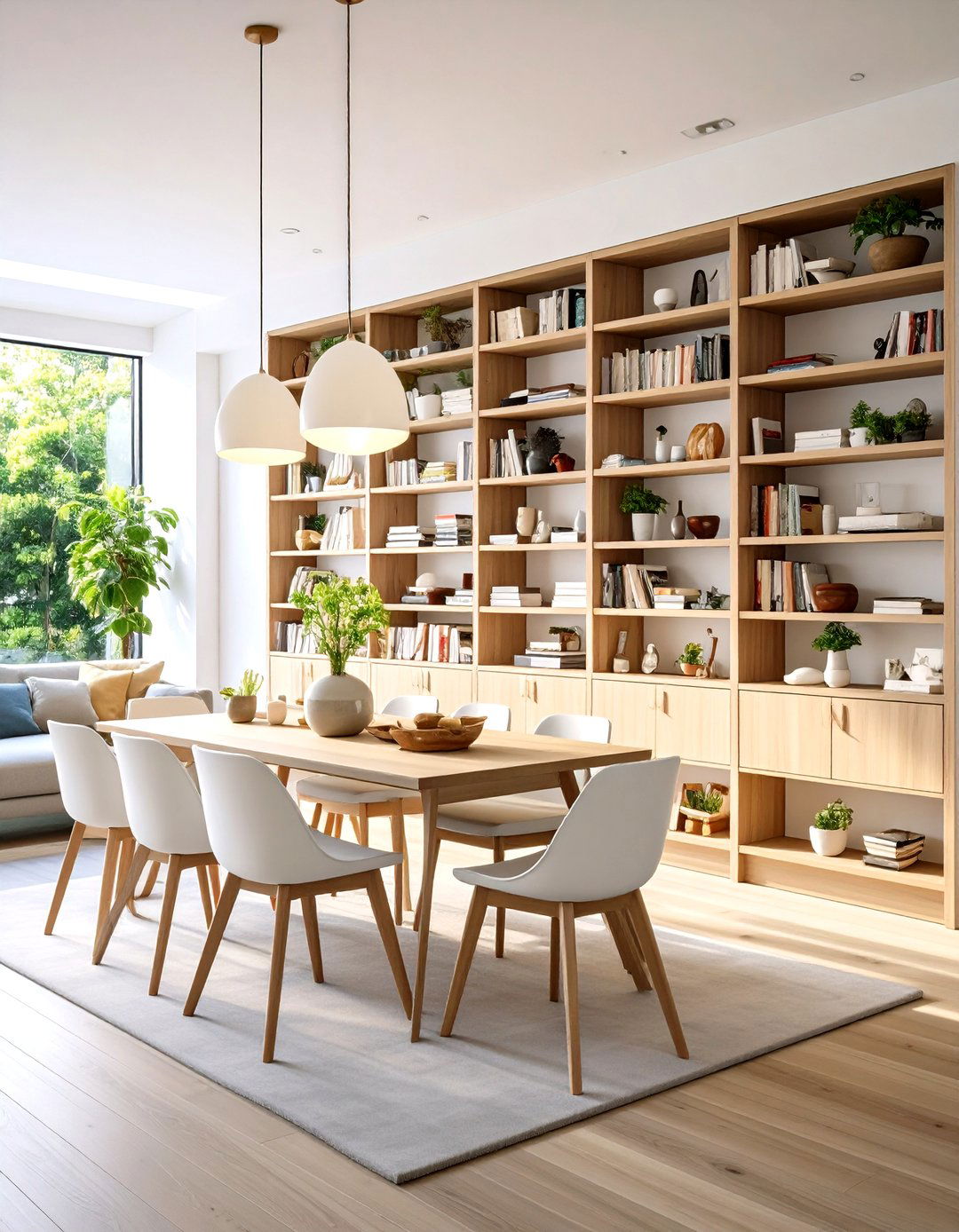
Take open-plan zones further by letting a single library wall serve both living and dining spaces. Build a double-sided partition clad in shelving; on the lounge side, display novels and a flat-mounted TV disguised behind artwork, while the dining side stores cookbooks, ceramics, and a shallow bar niche. Sliding panels between the two cores hide entertainment clutter during dinner parties, and rotary shelves can even pivot 180 degrees to reface depending on occasion. This multifunctional strategy keeps every meal and movie night literally surrounded by ideas. Elle Decor
13. Curved Corner Bookcase Library
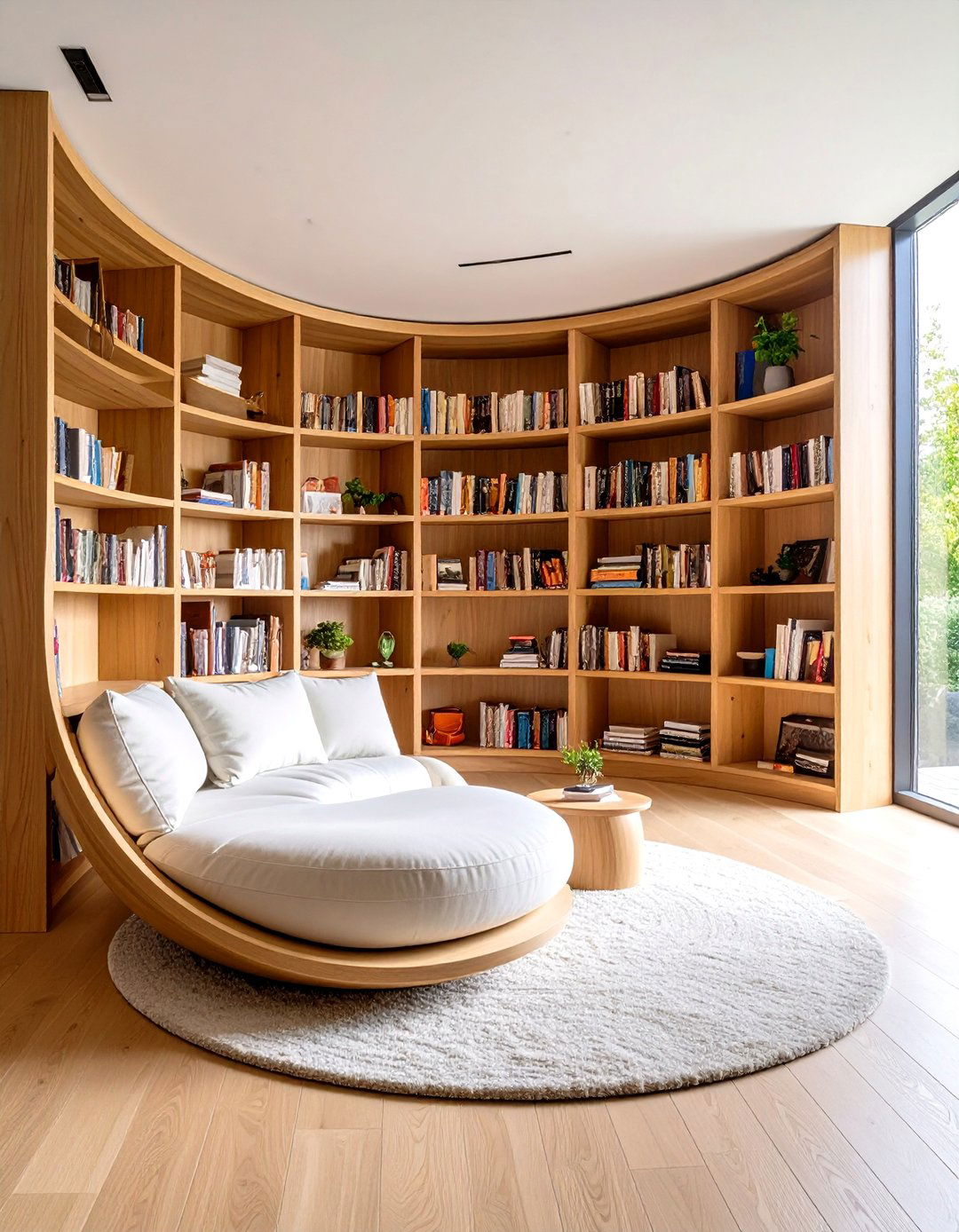
Despite the boxy nature of most rooms, a curved corner home library softens sightlines and invites lingering touch. Custom-bent plywood or flexible MDF panels allow radius shelves that cradle books like amphitheater seating around a central lounge pouf. The gentle arc guides the eye along continuous spines, making small collections appear fuller. Paired with wall-washing sconces that emphasise the curvature, the installation feels bespoke yet surprisingly space-efficient, turning an awkward 90-degree junction into the room’s most coveted seat. Homes & Gardens
14. Attic Retreat Home Library
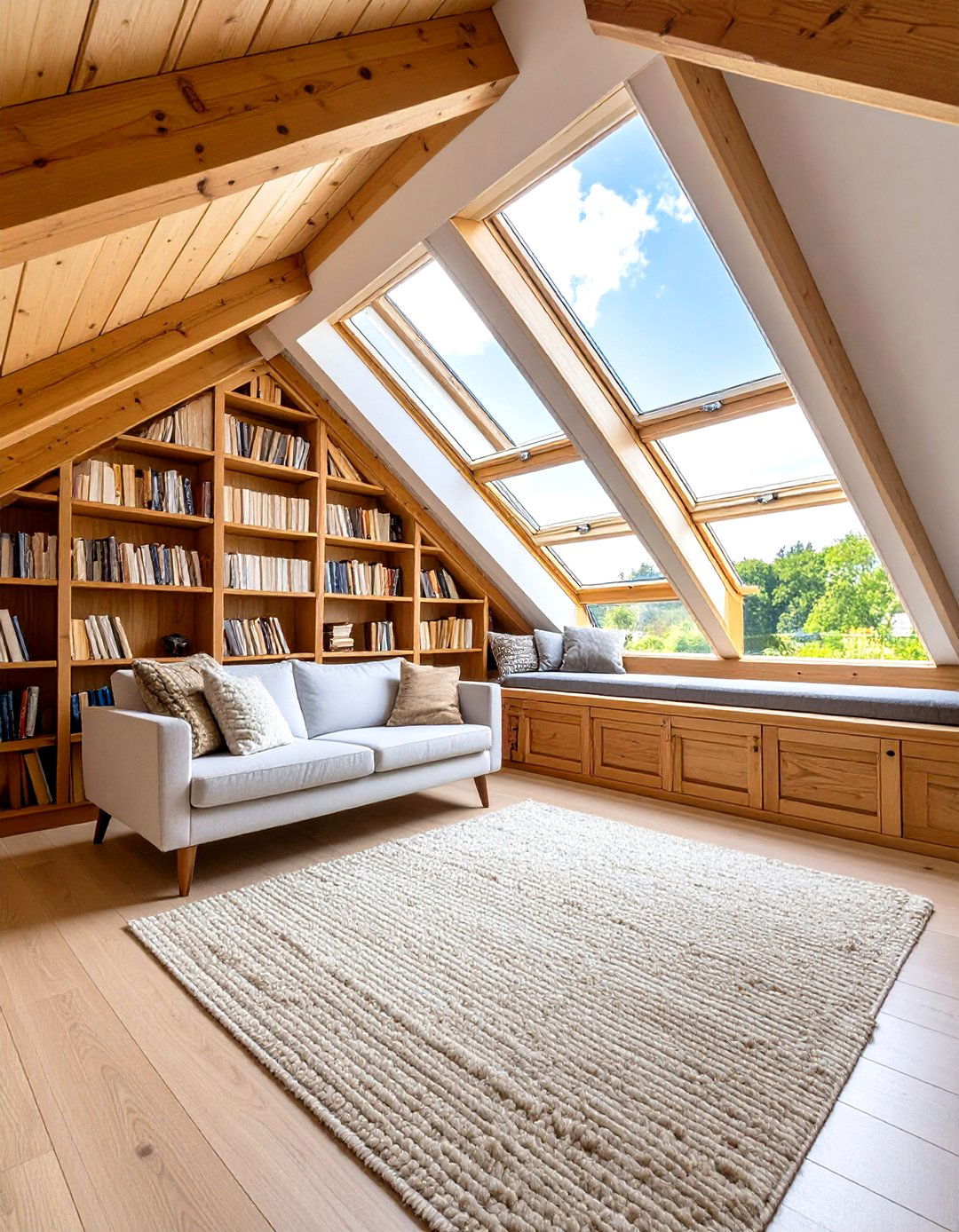
Owing to its pitched ceilings and away-from-traffic quiet, an attic makes a naturally cocooning library retreat. Line the short kneewalls with custom cabinets no more than forty-two centimeters deep to fit between rafters, reserving taller trays for folios in the central gable. Skylights should receive UV-filter film and interior blackout blinds to protect pages on bright days, while a low-profile radiant rug keeps feet warm across colder seasons. Add a small dormer window seat if budget allows, delivering both headroom and storybook charm. Homes & Gardens
15. Library with Rolling Ladder System
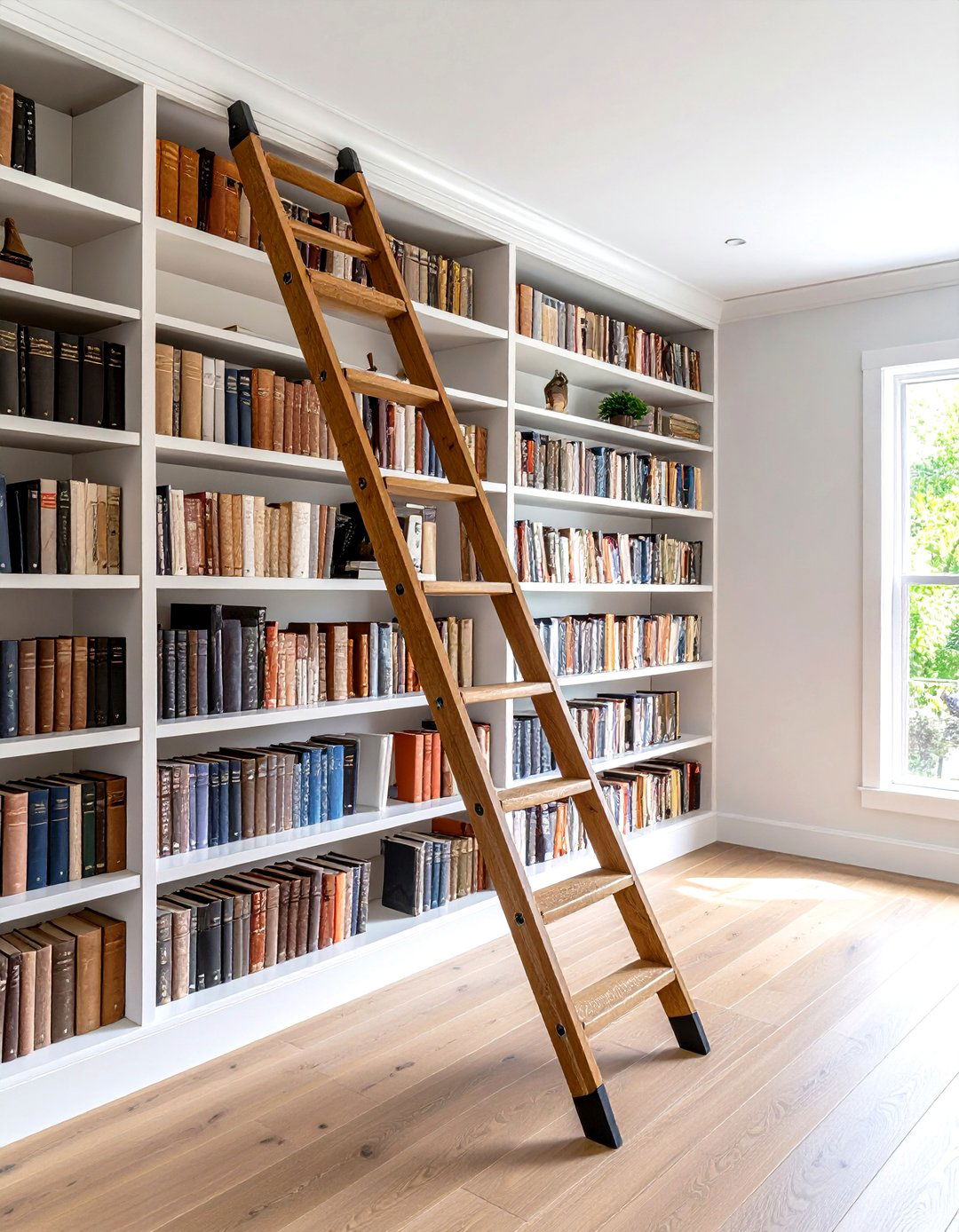
Those who adore lofty shelves can’t ignore the romance (and practicality) of a classic rolling ladder in their home library. Modern kits feature quiet, soft-close wheels that glide on sleek metal rails, available in matte black or brushed brass to match hardware themes. Safety rails at ladder tops and removable locking pins keep children’s hands out of danger. Consider storing decorative folios or seldom-used reference atlases on uppermost rows, leaving everyday reads within arm’s reach. The ladder itself becomes sculptural art, evoking grand public libraries in a domestic footprint. Homes & Gardens
16. Children’s Imagination Library Zone
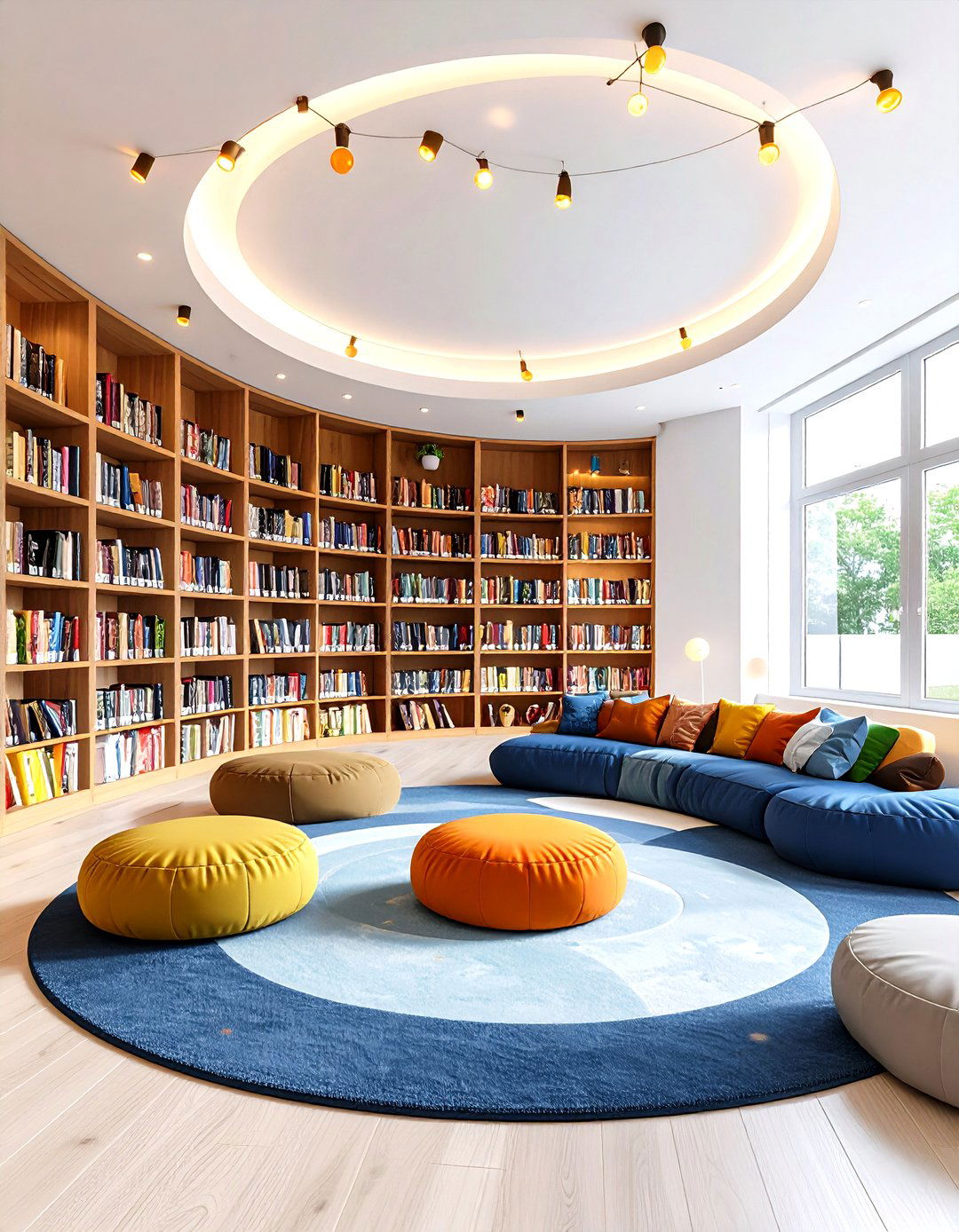
Looking at childhood through a literary lens, dedicate a low-shelved home library corner that nurtures early readers. Paint cubbies in cheerful gradients, arrange books face-out like gallery prints, and tuck in a whimsical rug shaped as a giant open book to cue play. A ceiling-hung canopy or twinkly fairy string lights builds fort-like ambience, signalling permission to dream. Keep seating flexible—a plush beanbag today, a wobble stool tomorrow—so the space evolves alongside growing attention spans. Add a chalkboard panel for kids to jot reviews of each finished tale, quietly cementing lifelong reading habits. Julie Blanner
17. Outdoor Garden Pavilion Library
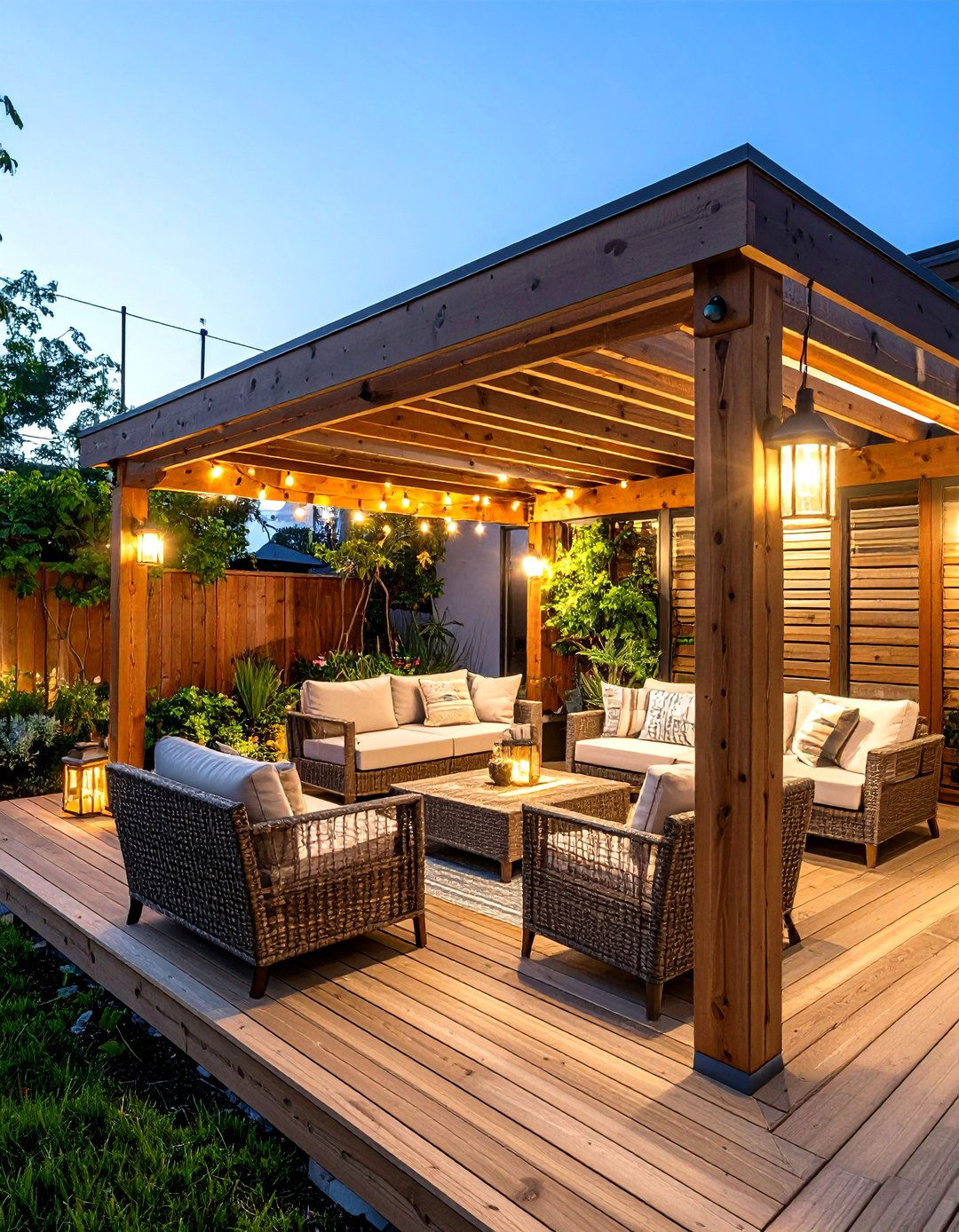
For climates allowing covered outdoor living, a garden pavilion home library merges literature with birdsong. Glaze three sides of a timber pergola in operable louvred glass to shelter shelves from drizzle while admitting cross-breezes. Cedar paneling naturally resists insects, and a ceiling fan keeps pages from wilting on humid afternoons. Furnish with weather-rated wicker loungers and a solar-powered lantern cluster so evenings remain readable without grid wiring. There’s nothing like finishing a nature memoir while leaves flicker right beyond your elbow. Elle Decor
18. Digital-Hybrid Smart Library Hub
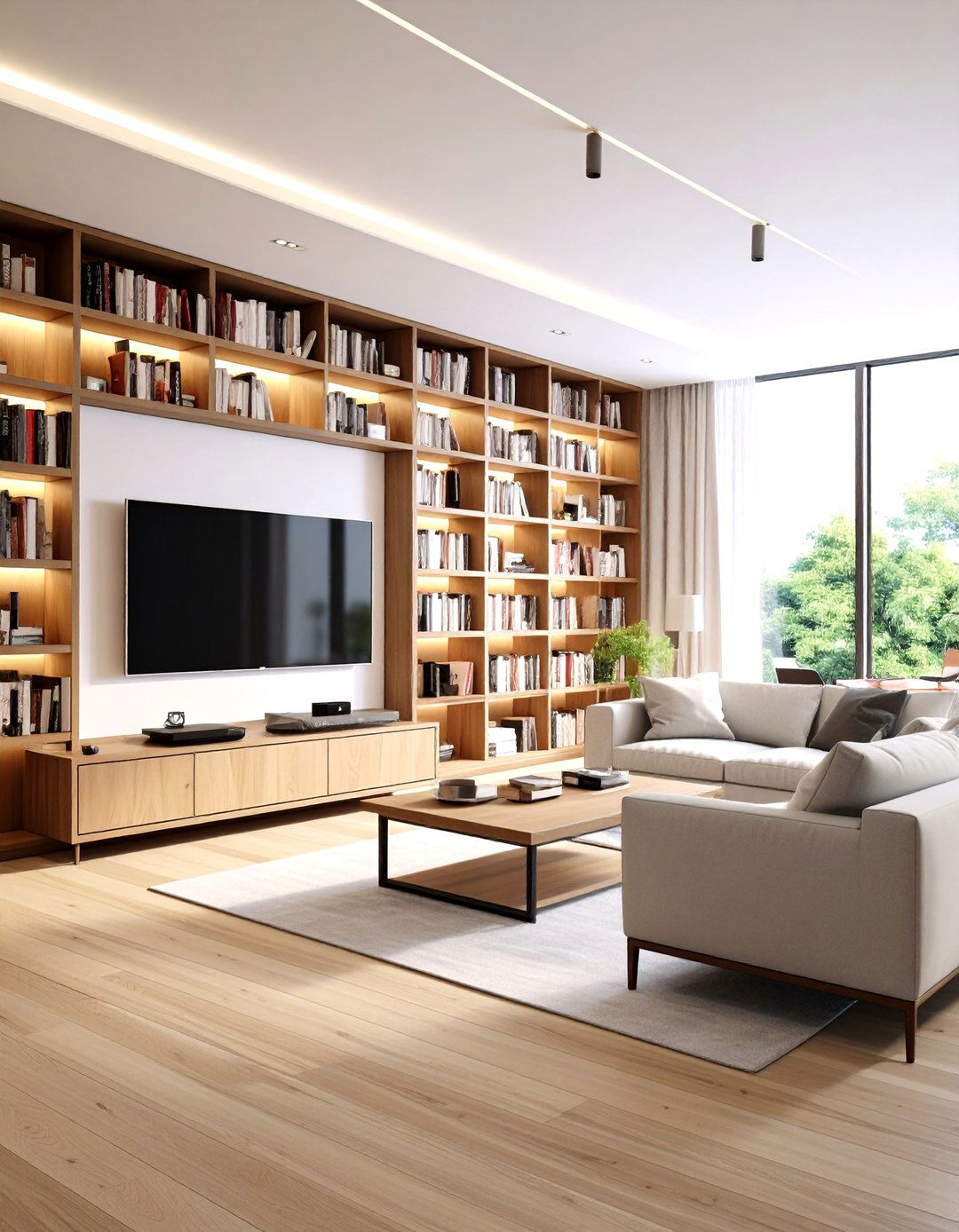
By harnessing tech, a digital-hybrid home library bridges paper and pixels elegantly. Mount a slim e-ink wall display that showcases rotating poetry excerpts or reading progress stats synced from your e-reader. Qi wireless chargers embedded in a walnut side table let you drop devices mid-chapter, while concealed cable conduits behind shelves keep routers out of view. Add voice-activated LED scenes—“story time,” “research mode”—to adjust brightness and soundtrack instantly. This integration honors traditional volumes yet adapts to our streaming habits. Elle Decor
19. Library Featuring Vintage Furnishings Trend
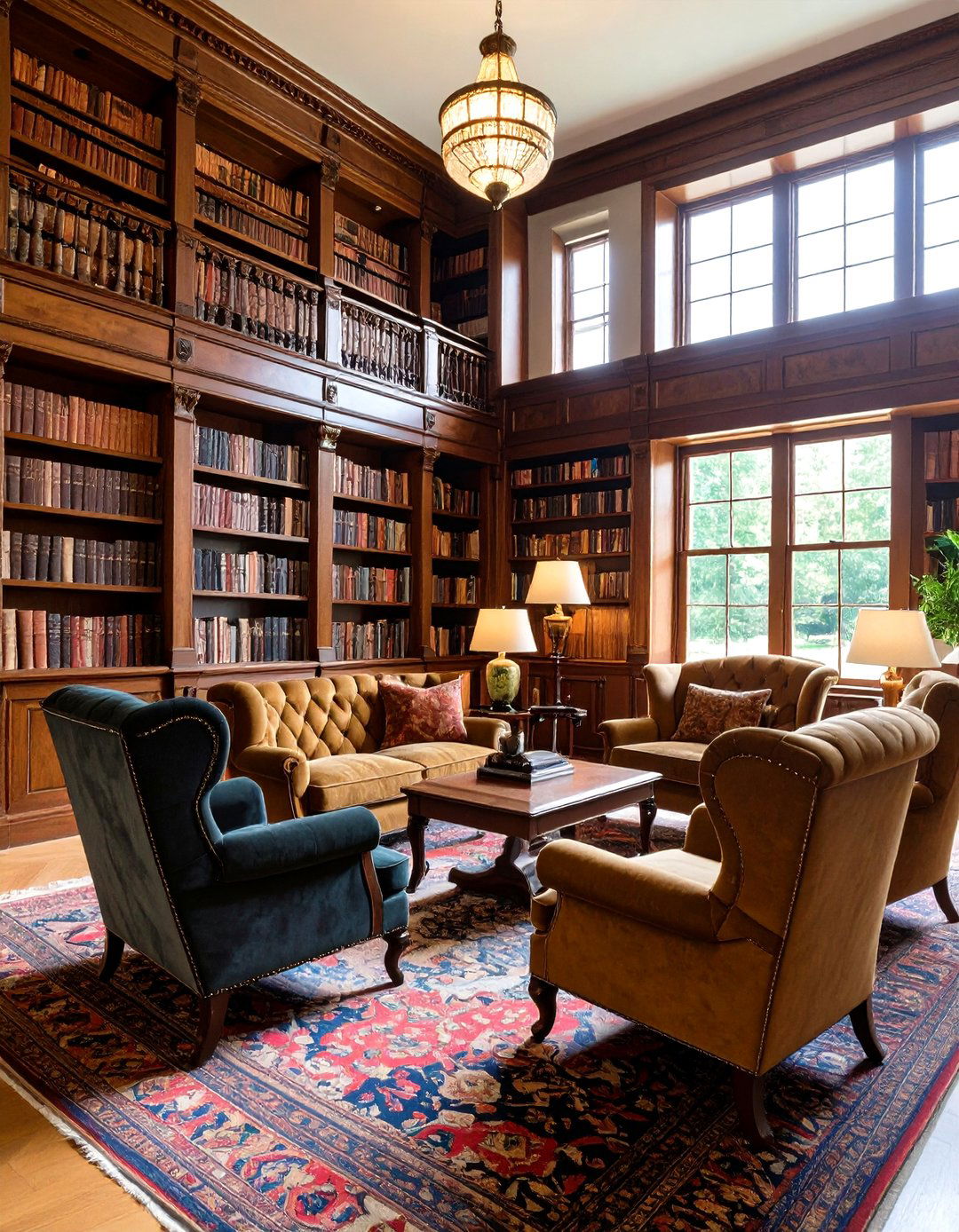
Surprisingly, the current passion for character-rich, tattooed furniture pairs perfectly with a curated home library. Salvaged armchairs reupholstered in embroidered velvet, or an antique credenza etched with personal motifs, add tactile storytelling that complements printed narratives. Mixing time-worn woods and patinated metals breaks the monotony of pristine shelves, making the room feel acquired over decades rather than assembled overnight. Use museum putty to secure collectibles on uneven surfaces, and layer a Persian-inspired rug whose faded reds echo classic clothbound editions. Architectural Digest
20. Sustainable Reclaimed-Wood Library Design
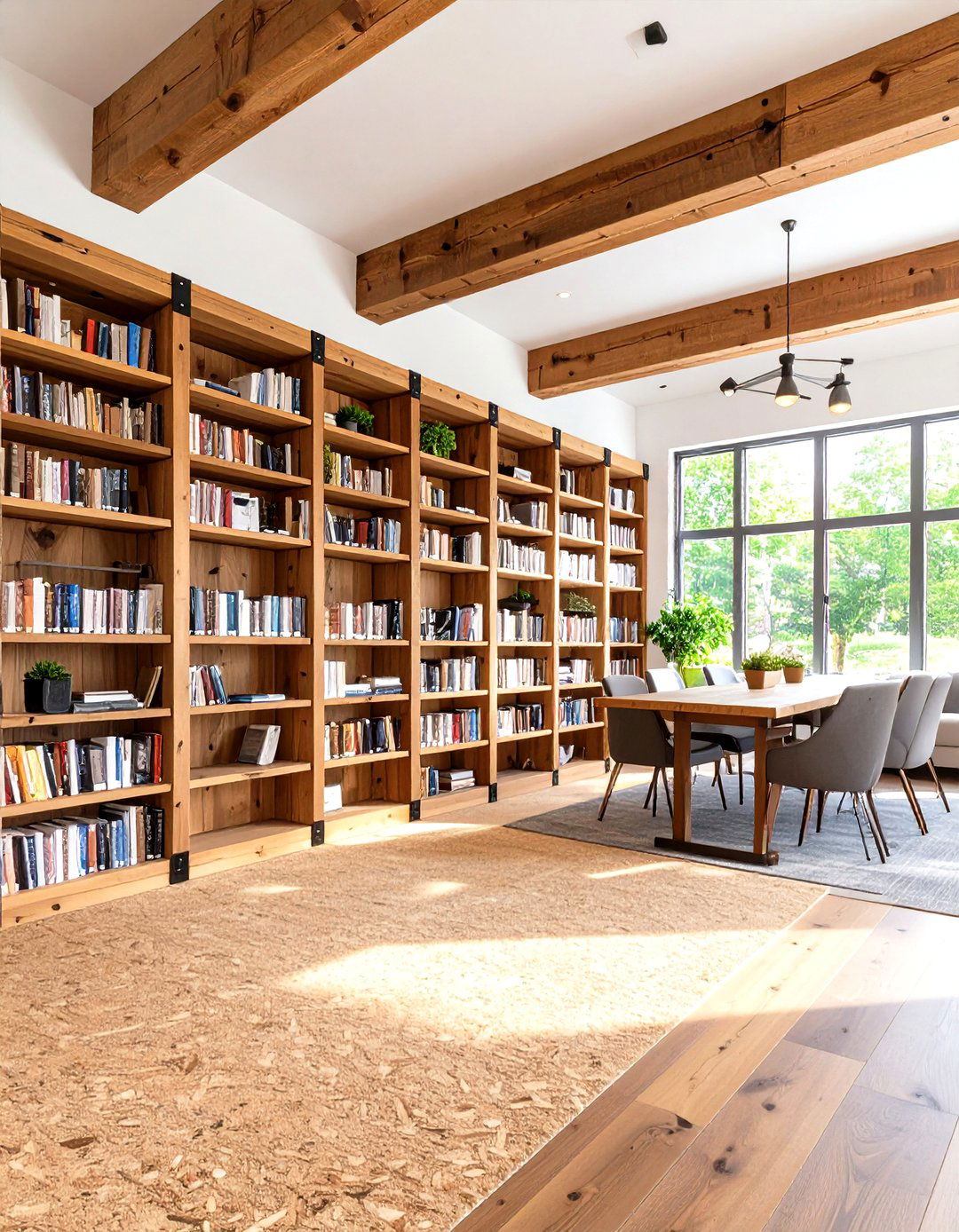
Finally, building your home library in reclaimed timber shows reverence for both planet and prose. Source old barn beams or shipping pallets planed smooth; their knots and nail holes supply organic texture no factory veneer can replicate. Seal surfaces with low-VOC oils, and pair with cork flooring to further dampen footsteps. Even hardware choices matter: opt for recycled-steel brackets or bamboo pegs instead of virgin metals. The resulting space tells a double story—every read accompanied by a silent chapter about conservation and thoughtful craft. Elle Decor
Conclusion:
All things considered, designing a home library today is less about square footage and more about attitude—finding fresh ways to let books anchor well-being, curiosity, and community. From secret doors that spark wonder to reclaimed timbers that honor sustainability, each idea here underscores how imaginative shelving, lighting, and seating can convert the most overlooked niche into a literary sanctuary. Blend one or blend several, scale them up or down, but give your stories a habitat that feels distinctly yours; when the surrounding space inspires, turning pages becomes not just a pastime, but a daily celebration.


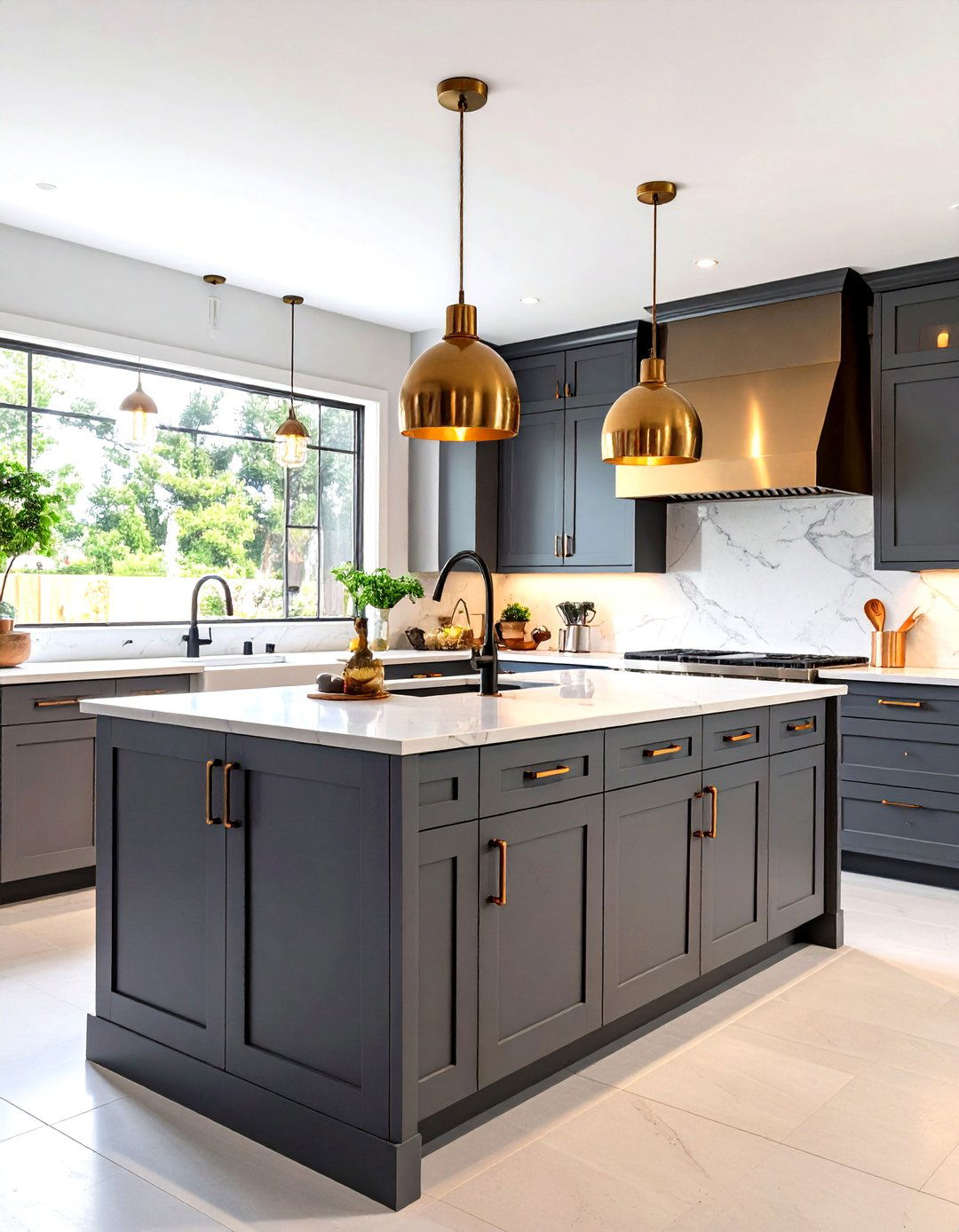





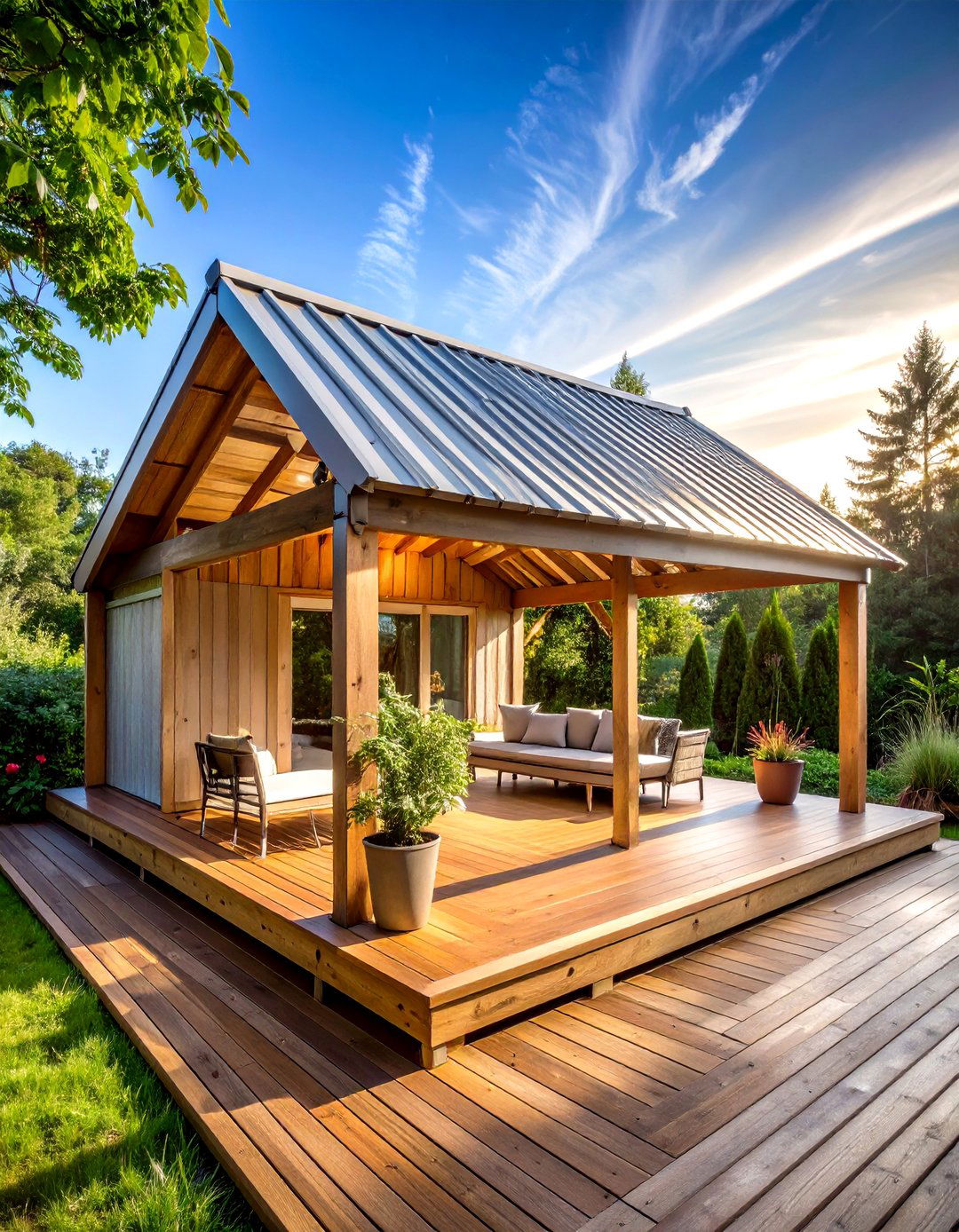
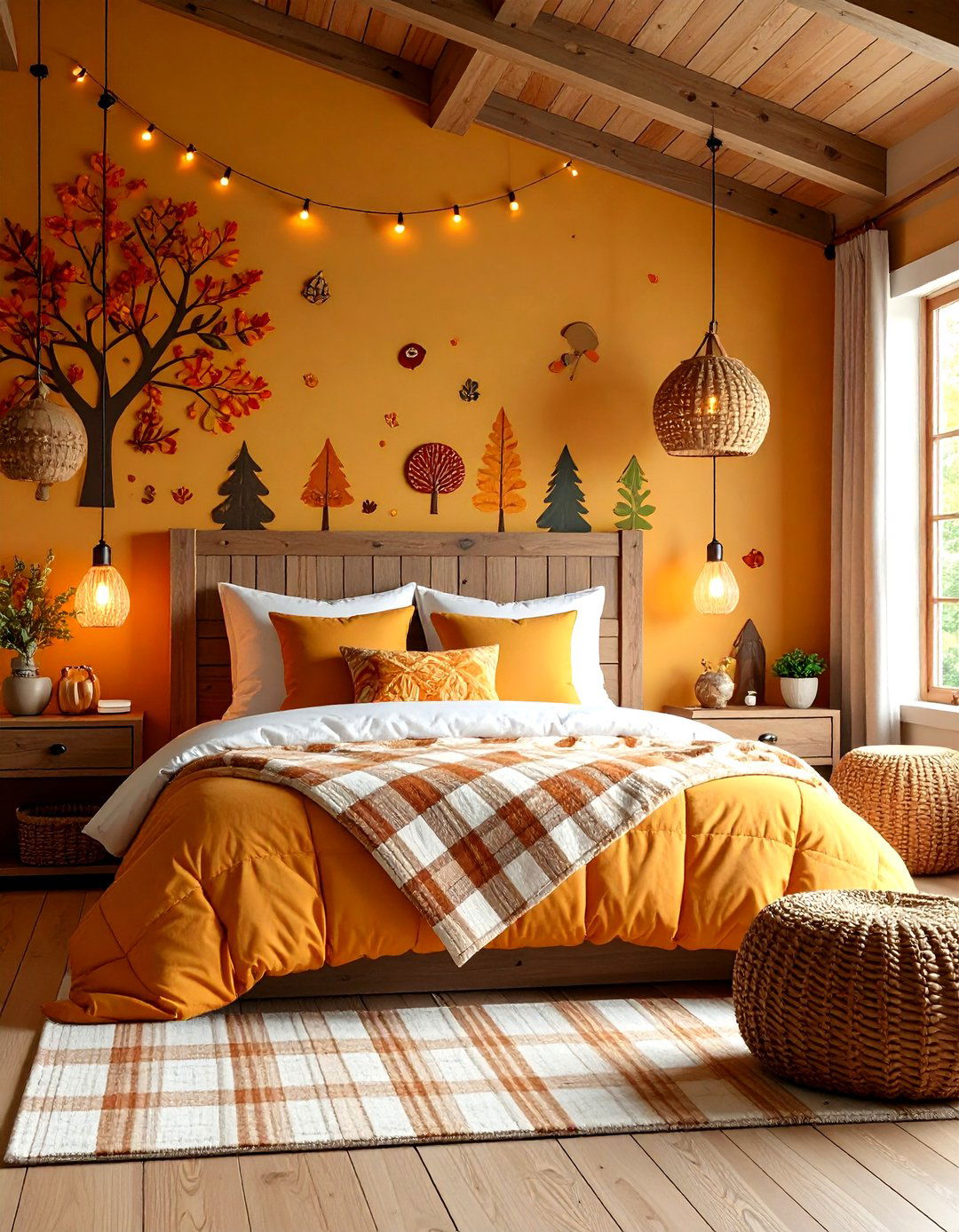



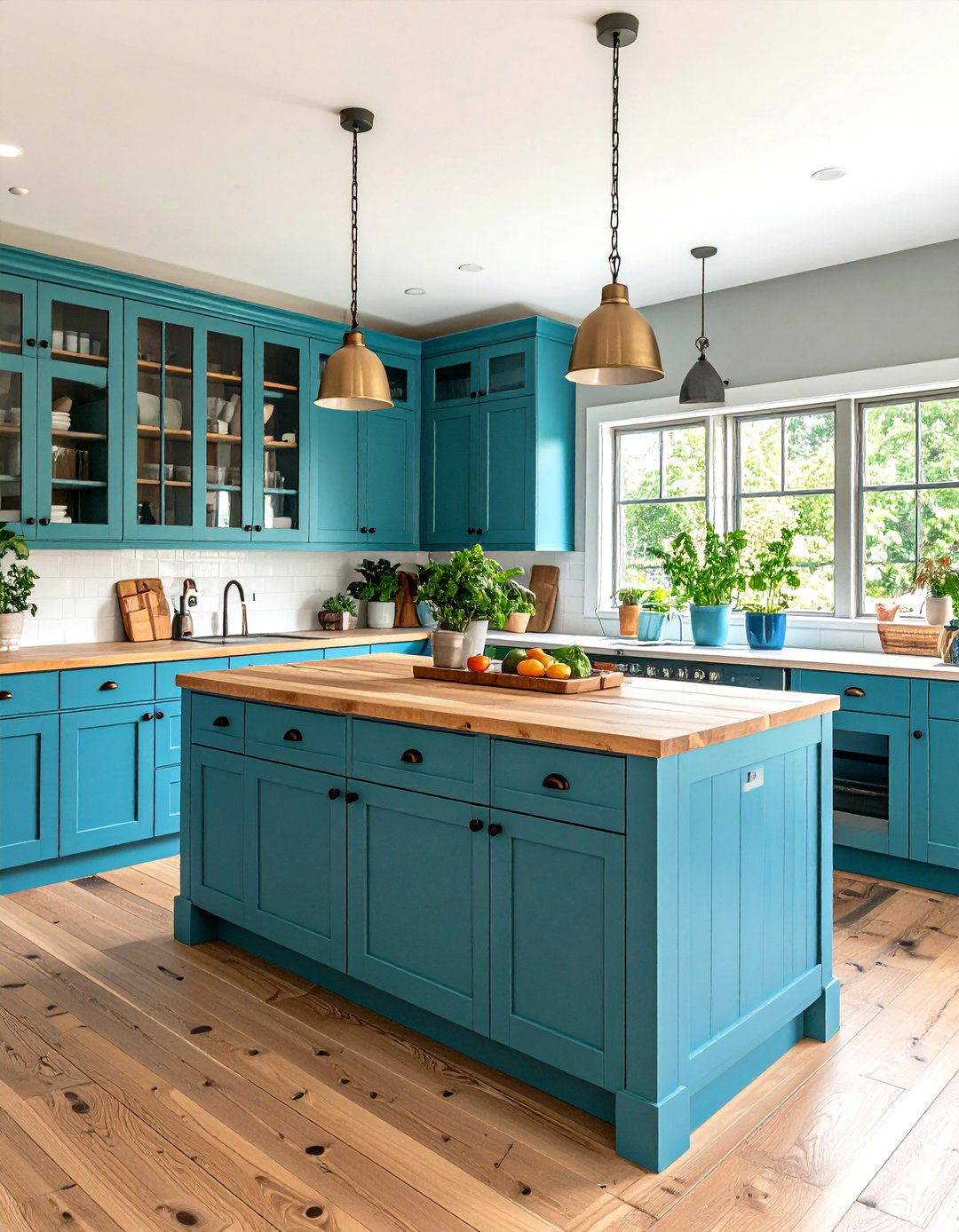
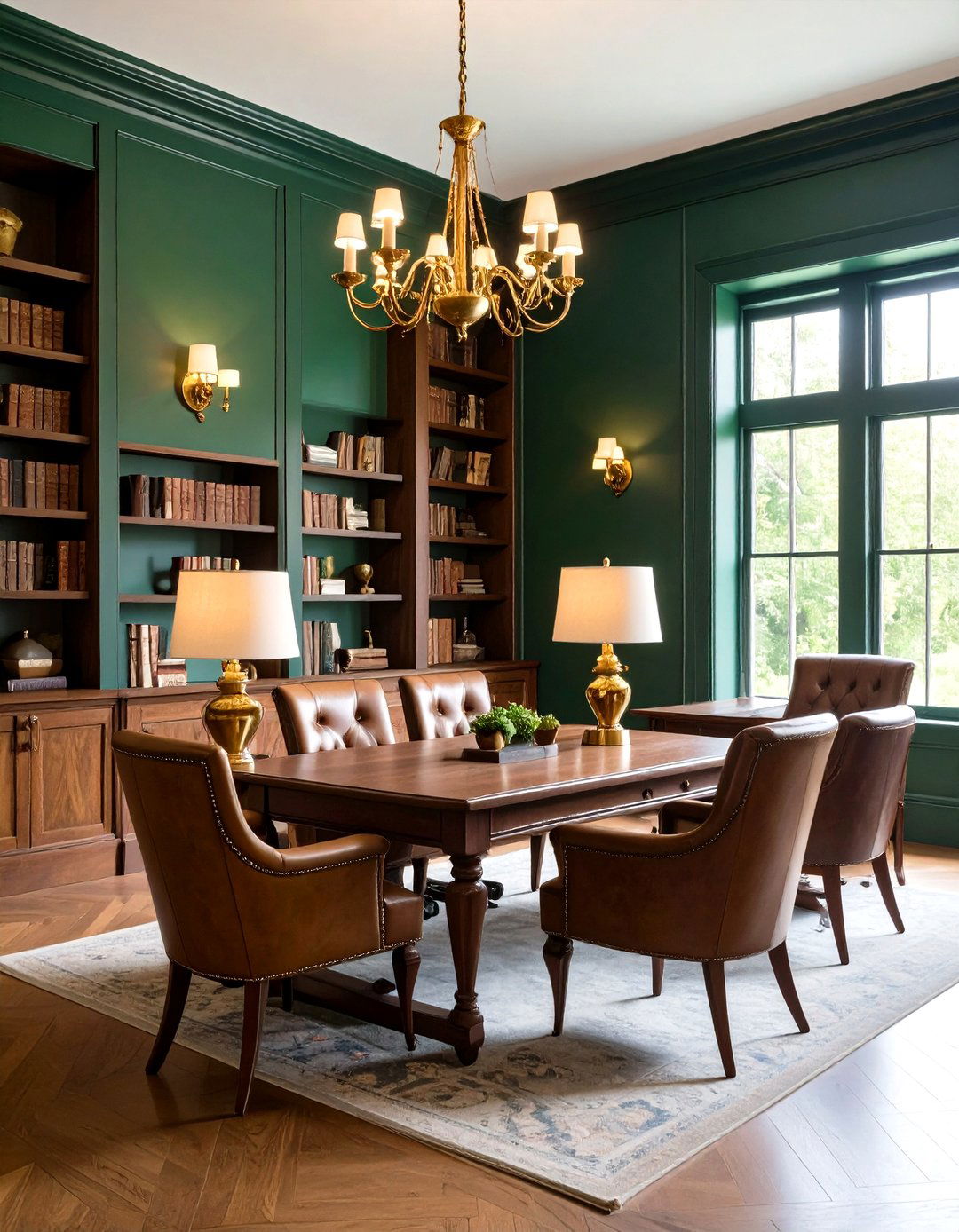
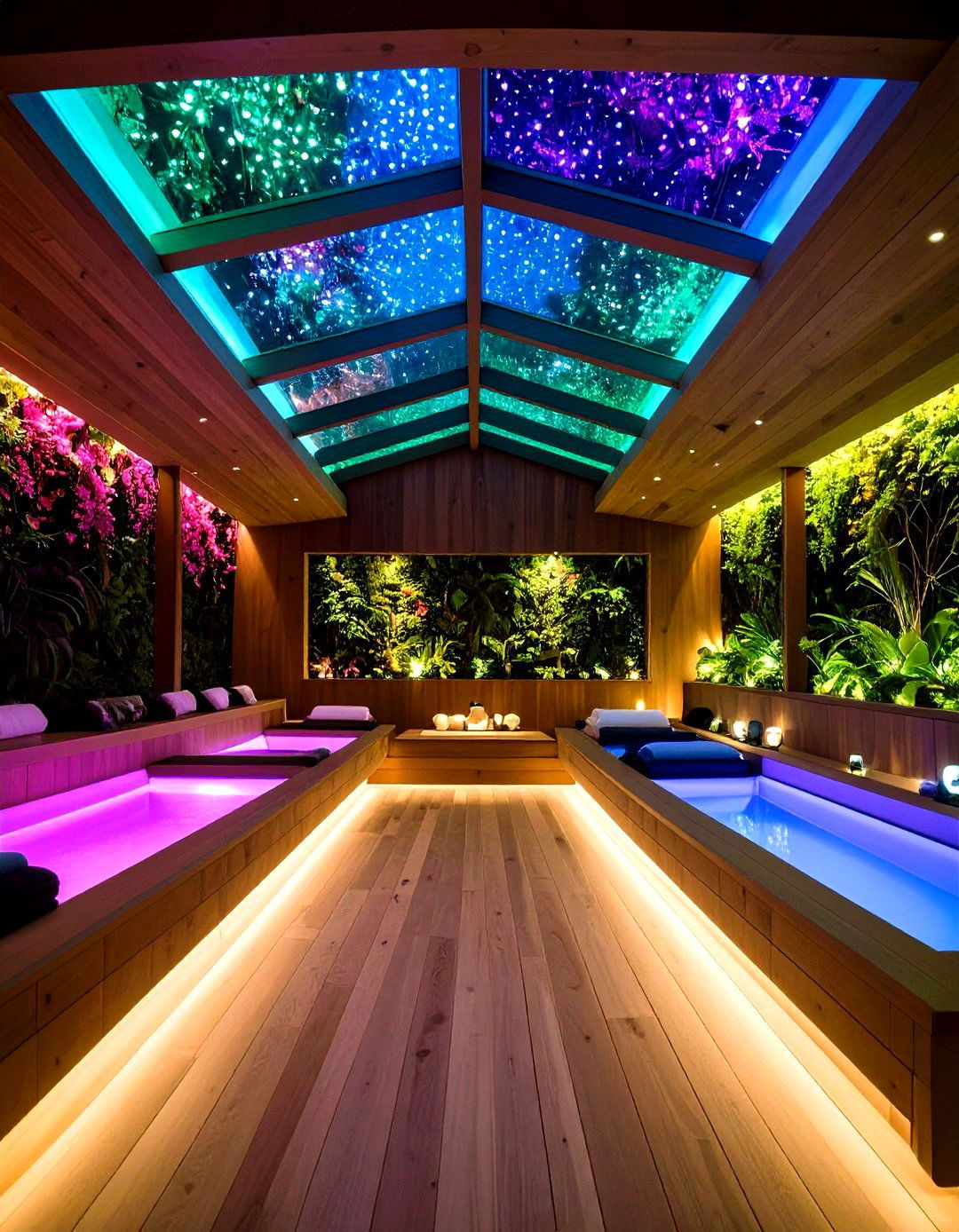
Leave a Reply